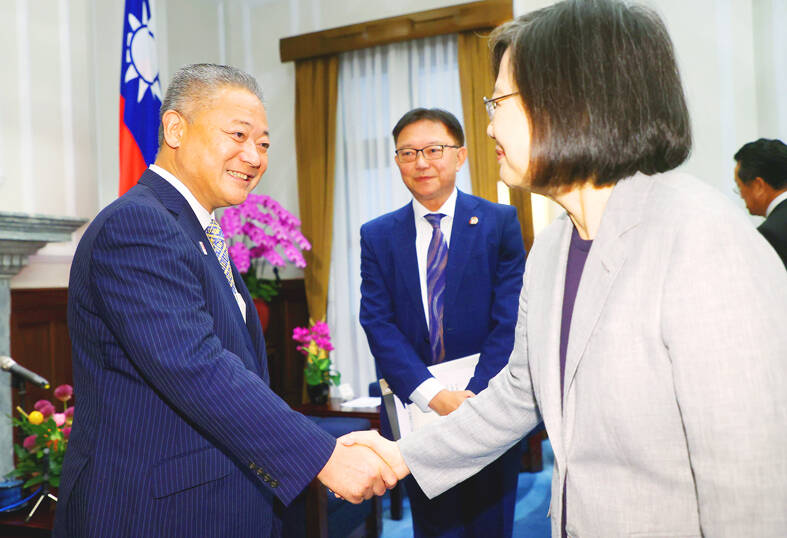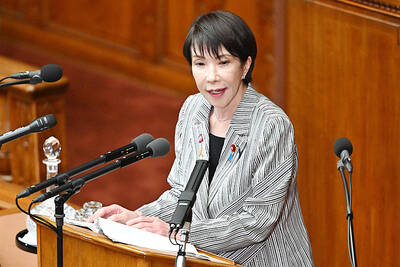“Taiwan’s peace is Japan’s peace,” visiting Japan Innovation Party leader Nobuyuki Baba told a news conference in Taipei on Wednesday, calling for joint efforts to deter a Chinese invasion.
Baba arrived in Taiwan on Tuesday for a three-day visit, leading nine other Japan Innovation Party lawmakers.
Both Tokyo and Taipei are doing their best to deter a Chinese attack, which would seriously affect the livelihoods of the more than 25,000 Japanese living in Taiwan, Baba said.

Photo: CNA
Any such military action would also likely affect Japanese islands near Taiwan, he added.
“Therefore, people in Japan believe in the saying that ‘a Taiwan emergency is a Japanese emergency,’ or we can say ‘Taiwan’s peace is Japan’s peace,’” he said.
Tokyo is seeking to increase defense spending to 2 percent of the nation’s GDP from the current 1 percent, he said.
Taiwan and Japan should work together to constitute a strong joint defense against Beijing, including by building deeper intelligence-sharing networks, he said.
Baba acknowledged that Japan and China have close economic and trade exchanges, with many Japanese companies doing business in China.
“We are not saying no to China on all fronts,” but as a country that values democracy and human rights, Japan is not accepting everything Beijing says and does, he said.
Earlier the same day, the group met with President Tsai Ing-wen (蔡英文), who urged the Japanese lawmakers to support Taiwan’s bid to join the Comprehensive and Progressive Agreement for Trans-Pacific Partnership.
In other news, Kevin Maher, former head of the Office of Japan Affairs at the US Department of State, told Nikkei Shimbun that Tokyo’s slow decisionmaking process would affect the US’ response in the event of a Chinese invasion of Taiwan.
The Tokyo-based think tank Japan Forum for Strategic Studies hosted a tabletop exercise in Tokyo last month in collaboration with military officials and analysts from Taiwan, the US and Japan simulating a Chinese invasion of Taiwan.
The exercise included a scenario in which the Chinese military landed on the Diaoyutai Islands (釣魚台), known as the Senkakus in Japan, Nikkei reported.
“We had to wait for the Japanese prime minister, in the scenario — two weeks — to say that this is an armed attack on Japan,” Maher said.
The US, Japan and Taiwan have to coordinate closely while preparing to respond to a crisis that would affect Taiwan, he said, adding that the Diaoyutai Islands must be included in the preparation, as it is closely tied to what would happen in Taiwan.
A slow decisionmaking process would weaken the effectiveness of deterrence, he said.
Tokyo must first declare the situation an “armed attack” against Japan for it to work with the US on a military response, he said.
If Japan delays such a declaration out of a desire to avoid conflict, “it really ties the US’ hands,” he added.
Christopher Johnstone, former East Asia director for the US National Security Council, urged the establishment of a trilateral mechanism of coordination between Japan, the US and Taiwan to decide the responsibilities of military operations and evacuating civilians, Nikkei reported.
During the tabletop simulation, “there was no discussion about Japan’s role, beyond defending its own territory,” he said.

The Central Weather Administration (CWA) yesterday said it expected to issue a sea warning for Typhoon Fung-Wong tomorrow, which it said would possibly make landfall near central Taiwan. As of 2am yesterday, Fung-Wong was about 1,760km southeast of Oluanpi (鵝鑾鼻), Taiwan’s southernmost point, moving west-northwest at 26kph. It is forecast to reach Luzon in the northern Philippines by tomorrow, the CWA said. After entering the South China Sea, Typhoon Fung-Wong is likely to turn northward toward Taiwan, CWA forecaster Chang Chun-yao (張峻堯) said, adding that it would likely make landfall near central Taiwan. The CWA expects to issue a land

Taiwan’s exports soared to an all-time high of US$61.8 billion last month, surging 49.7 percent from a year earlier, as the global frenzy for artificial intelligence (AI) applications and new consumer electronics powered shipments of high-tech goods, the Ministry of Finance said yesterday. It was the first time exports had exceeded the US$60 billion mark, fueled by the global boom in AI development that has significantly boosted Taiwanese companies across the international supply chain, Department of Statistics Director-General Beatrice Tsai (蔡美娜) told a media briefing. “There is a consensus among major AI players that the upcycle is still in its early stage,”

The Central Weather Administration (CWA) yesterday said it is expected to issue a sea warning for Typhoon Fung-wong this afternoon and a land warning tomorrow. As of 1pm, the storm was about 1,070km southeast of Oluanpi (鵝鑾鼻), Taiwan’s southernmost point, and was moving west-northwest at 28 to 32kph, according to CWA data. The storm had a radius of 250km, with maximum sustained winds of 173kph and gusts reaching 209kph, the CWA added. The storm is forecast to pass near Luzon in the Philippines before entering the South China Sea and potentially turning northward toward Taiwan, the CWA said. CWA forecaster Chang Chun-yao (張峻堯) said

Japanese Prime Minister Sanae Takaichi yesterday said that China using armed force against Taiwan could constitute a "survival-threatening situation" for Japan, allowing the country to mobilize the Japanese armed forces under its security laws. Takaichi made the remarks during a parliamentary session while responding to a question about whether a "Taiwan contingency" involving a Chinese naval blockade would qualify as a "survival-threatening situation" for Japan, according to a report by Japan’s Asahi Shimbun. "If warships are used and other armed actions are involved, I believe this could constitute a survival-threatening situation," Takaichi was quoted as saying in the report. Under Japan’s security legislation,